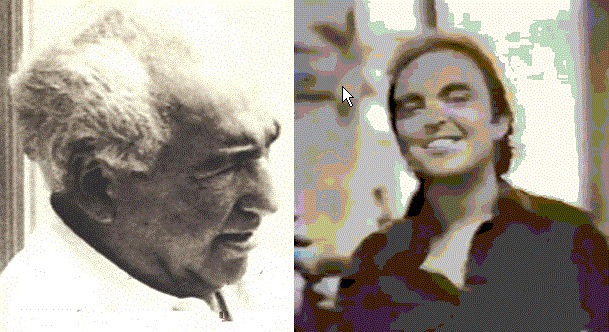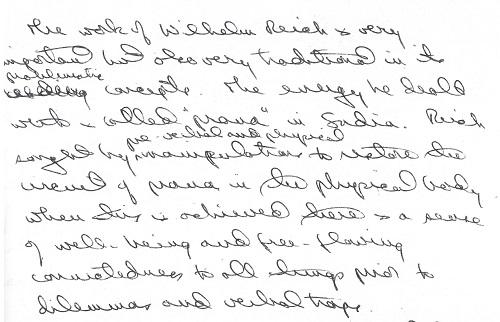
Wilhelm Reich and Franklin Jones (Adi Da)

Franklin Jones, 1971
![]() he work of Wilhelm Reich is very important, but also very traditional in its problematic concepts. The energy he dealt with is called prana in India. Reich sought by pre-verbal and physical manipulations to restore the circuit of prana in the physical body. When this is achieved, there is a sense of well-being and free-flowing connectedness to all things prior to dilemmas and verbal traps. However, Reich saw this state as an end in itself, whereas it is simply a functional capability that is the ground of higher creative controls and conscious capability. The state of orgasmic potency, the ability to release and stabilize the circuit of prana is only a secondary human state. It is a secondary complement to full creative life, but it is not itself sufficient, real, or truly conscious. The need to release stored up prana is only a secondary excitation. It is a possibility, a pleasure, and a capacity that should be free and conscious, but it is not a necessary function of absolute philosophical importance.
he work of Wilhelm Reich is very important, but also very traditional in its problematic concepts. The energy he dealt with is called prana in India. Reich sought by pre-verbal and physical manipulations to restore the circuit of prana in the physical body. When this is achieved, there is a sense of well-being and free-flowing connectedness to all things prior to dilemmas and verbal traps. However, Reich saw this state as an end in itself, whereas it is simply a functional capability that is the ground of higher creative controls and conscious capability. The state of orgasmic potency, the ability to release and stabilize the circuit of prana is only a secondary human state. It is a secondary complement to full creative life, but it is not itself sufficient, real, or truly conscious. The need to release stored up prana is only a secondary excitation. It is a possibility, a pleasure, and a capacity that should be free and conscious, but it is not a necessary function of absolute philosophical importance.
One who is aware of the circuit of energy in the body should know that it is not a linear polarized line of force. It is a circuit or round and therefore, it is not necessary to release energy through the lower exits. We have the capacity to enjoy the creative functions of energy by its release or sharing through the many exits along the line or circuit of our form. But release is not necessary. Energy is not stored. There is no necessary pressure created by the flow of energy. It is only necessary to know the possible functions and the forms through which it communicates, represents, or releases itself to combine with other fields of force. What is necessary is not any particular place or form of release, but the form or circuit itself, which always already exists. The circuit of our form which flows energy on many levels, in many types of body, is a circuit or circle.
Energy descends in front and ascends in back. Reich, in typical fashion, was concerned for the descending portion and the life function of energy. He was concerned for necessary release at the lowest point or terminal of descent, the sexual zone. This was a traditional emphasis. In the East, there are also sciences of prana or Shakti. I have worked with them. There, the traditional emphasis is upon the ascending portion of the cycle of energy, and the teachers are concerned with the direction and release of energy into the end terminal of ascent, the upper regions of the head. In fact, the circle of form has no necessary end terminal. Exclusive ascent or descent is not appropriate or necessary to it. The circle emanates from and surrounds the heart. And this is the source, control, and consciousness that is of radical importance to any form of life. Therefore, it is not necessary to terminate, direct, or release energy at any point, high or low.
One who understands and lives as the heart becomes aware of the full circle of form and all the uses of energy, but only the heart is necessary to him or her. He is not concerned to release energy or to epitomize it. He or she uses it in many ways with free intelligence. He does not maintain stability through the techniques of release or storage. Instead, apart from any particular use, he maintains the circuit of reality and enjoys the circular continuous flow of force. Therefore, he is not concerned with the contraction of release of energy in the terminals of descent, culminating in sexual love, or the terminals of ascent, culminating in spiritual consciousness and subtle bliss. He enjoys all these things, but his essential action and enjoyment is not in release but in the full circle.
Where the sexual and spiritual types tend to direct and release energy in their traditional ways, the man of understanding allows energy to continue from the end terminals of ascent and descent toward the opposite in a continuous circle. His enjoyment is the heart itself, unqualified consciousness with all capabilities, the tendency to release energy and thereby to enjoy union or sublimation into other fields of force or to store energy in its original state, in the Sahastra, the terminal of the upper brain, without differentiation is unnecessary. The functions of energy are not of radical importance. They are always a matter of creative use rather than necessity.
Therefore, in the man of understanding, energies flow in a continuous circle around the heart, every center is open, not chronically contracted. The pressure of energy does not build up to the point of demanding release. He can release it and enjoy creative, fulfilling play or love, but he need not. The energy that flows in a continuous circle around the heart does not enforce pressure at any point. Release is not necessary, nor can there be any real emptying of force, since the man of understanding comes to enjoy the totality of energy and all forms as his own form. The man of understanding is power and capability, but he is soft and round. He is all openness and continuous flow. The navel and the head centers, the Sahastra, our primary terminals, great with force, full and soft, potent and bright. He is the signal of the truth of force, of energy and creative life.
Reich, like other great and intuitive men, dealt with this possibility under the forms of limitation and secondary necessity, but this does not qualify the great value of his demonstration and the genuinely usefulness benefits of his work. It is only necessary for him to be understood so that his discoveries can be grasped in a science of the whole.
See more on the work of “Conductivity” by Adi Da Samraj